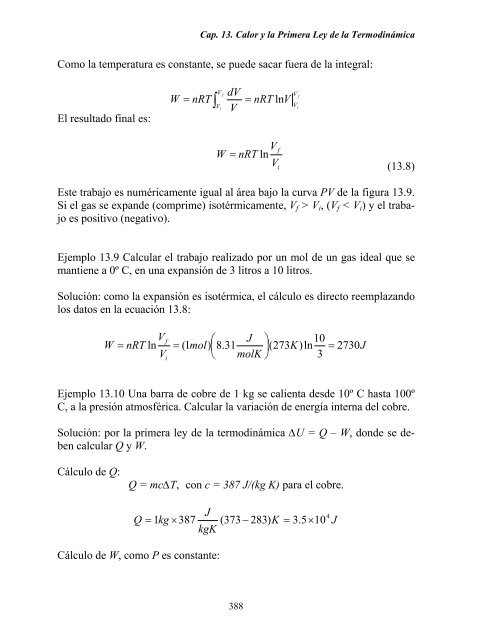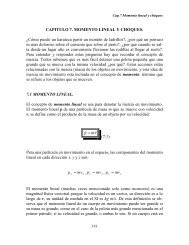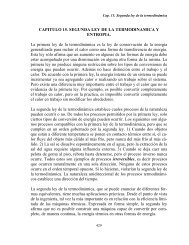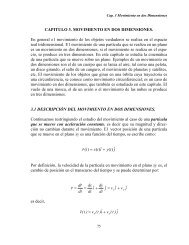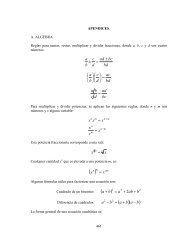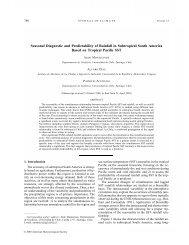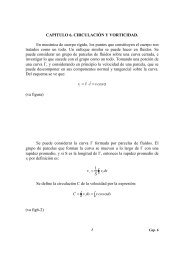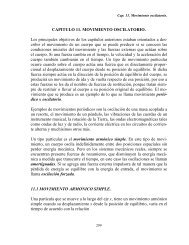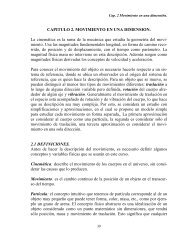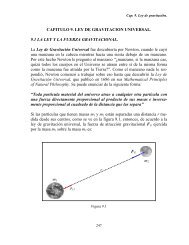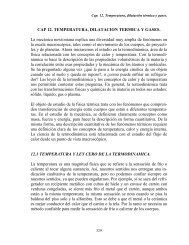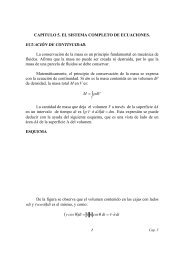Capítulo 13. Calor y la primera ley de - DGEO
Capítulo 13. Calor y la primera ley de - DGEO
Capítulo 13. Calor y la primera ley de - DGEO
Create successful ePaper yourself
Turn your PDF publications into a flip-book with our unique Google optimized e-Paper software.
Cap. <strong>13.</strong> <strong>Calor</strong> y <strong>la</strong> Primera Ley <strong>de</strong> <strong>la</strong> Termodinámica<br />
Como <strong>la</strong> temperatura es constante, se pue<strong>de</strong> sacar fuera <strong>de</strong> <strong>la</strong> integral:<br />
El resultado final es:<br />
V<br />
dV<br />
V<br />
f<br />
W nRT = nRT ln<br />
Vi<br />
= ∫<br />
V f<br />
W = nRT ln<br />
V<br />
388<br />
i<br />
V<br />
V<br />
V<br />
i<br />
f<br />
(<strong>13.</strong>8)<br />
Este trabajo es numéricamente igual al área bajo <strong>la</strong> curva PV <strong>de</strong> <strong>la</strong> figura <strong>13.</strong>9.<br />
Si el gas se expan<strong>de</strong> (comprime) isotérmicamente, Vf > Vi, (Vf < Vi) y el trabajo<br />
es positivo (negativo).<br />
Ejemplo <strong>13.</strong>9 Calcu<strong>la</strong>r el trabajo realizado por un mol <strong>de</strong> un gas i<strong>de</strong>al que se<br />
mantiene a 0º C, en una expansión <strong>de</strong> 3 litros a 10 litros.<br />
Solución: como <strong>la</strong> expansión es isotérmica, el cálculo es directo reemp<strong>la</strong>zando<br />
los datos en <strong>la</strong> ecuación <strong>13.</strong>8:<br />
V f ⎛ J ⎞ 10<br />
W = nRT ln = ( 1mol)<br />
⎜8.<br />
31 ⎟(<br />
273K)<br />
ln = 2730J<br />
V ⎝ molK ⎠ 3<br />
i<br />
Ejemplo <strong>13.</strong>10 Una barra <strong>de</strong> cobre <strong>de</strong> 1 kg se calienta <strong>de</strong>s<strong>de</strong> 10º C hasta 100º<br />
C, a <strong>la</strong> presión atmosférica. Calcu<strong>la</strong>r <strong>la</strong> variación <strong>de</strong> energía interna <strong>de</strong>l cobre.<br />
Solución: por <strong>la</strong> <strong>primera</strong> <strong>ley</strong> <strong>de</strong> <strong>la</strong> termodinámica ∆U = Q – W, don<strong>de</strong> se <strong>de</strong>ben<br />
calcu<strong>la</strong>r Q y W.<br />
Cálculo <strong>de</strong> Q:<br />
Q = mc∆T, con c = 387 J/(kg K) para el cobre.<br />
J<br />
Q = 1 kg × 387 ( 373 − 283)<br />
K = 3.<br />
5×<br />
10<br />
kgK<br />
Cálculo <strong>de</strong> W, como P es constante:<br />
4<br />
J


